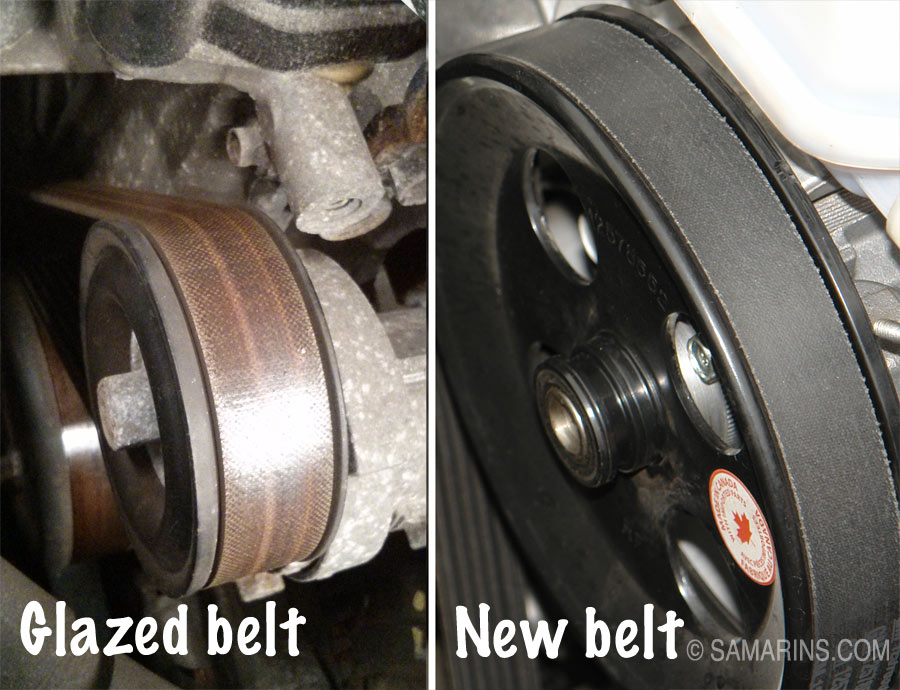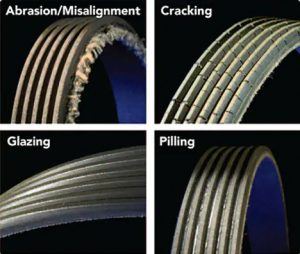Serpentine belt problems can lead to engine performance issues and accessory failure. Common signs include squeaking noises, visible wear, and dashboard warning lights.
The serpentine belt plays a crucial role in your vehicle’s performance. It powers multiple components, including the alternator, power steering pump, and air conditioning compressor. A worn or damaged belt can cause significant problems, leading to decreased efficiency and potential breakdowns.
Regular inspection and maintenance are vital to ensure the serpentine belt remains in good condition. Ignoring signs of wear can result in costly repairs and inconveniences. Understanding the symptoms of serpentine belt issues can help you take timely action, ensuring your vehicle runs smoothly and reliably. Stay informed to maintain your vehicle’s health and performance.
Introduction To Serpentine Belt Issues
The serpentine belt is vital for your vehicle’s performance. It connects various engine components. Problems with this belt can lead to serious issues. Understanding these problems helps in timely maintenance.
The Role Of The Serpentine Belt
The serpentine belt plays a crucial role in your car. It powers multiple accessories. These include:
- Alternator
- Power steering pump
- Water pump
- Air conditioning compressor
Without a functioning serpentine belt, your vehicle struggles. It can lead to overheating and power loss. Regular checks ensure it runs smoothly.
Common Reasons For Serpentine Belt Failures
Several factors can cause the serpentine belt to fail. Knowing these helps in prevention. Here are the common reasons:
| Cause | Description |
|---|---|
| Wear and Tear | Age leads to cracks and fraying. |
| Poor Alignment | Misaligned pulleys cause uneven wear. |
| Temperature Extremes | High heat can degrade the belt material. |
| Oil or Fluid Leaks | Fluids can weaken the belt structure. |
| Improper Tension | Too much or too little tension affects performance. |
Regular inspections can help catch these issues early. Maintain proper tension and alignment to avoid problems.

Credit: www.samarins.com
Identifying Serpentine Belt Problems
Serpentine belts play a crucial role in your vehicle’s performance. Detecting problems early can save time and money. This section provides tips for identifying issues with your serpentine belt.
Visual Inspection Tips
A visual check can reveal many serpentine belt problems. Look for these signs:
- Cracks: Small cracks indicate wear and tear.
- Fraying: Threads coming apart suggest a failing belt.
- Glazing: A shiny surface indicates slipping.
- Missing Sections: Look for gaps in the belt.
Use a flashlight for better visibility. Inspect the belt from various angles. Check the tensioner and pulleys too. They should not show signs of damage.
Auditory Clues Of Belt Distress
Sounds can help identify serpentine belt issues. Pay attention to these noises:
- Squealing: Often indicates slipping.
- Chirping: May suggest misalignment.
- Grinding: Signals potential pulley issues.
Listen carefully when starting your vehicle. Any unusual sounds should prompt further inspection. A quiet belt usually means it’s in good condition.
Consequences Of A Faulty Serpentine Belt
A faulty serpentine belt can lead to serious vehicle issues. Understanding these consequences helps in early detection and repair. Ignoring problems can worsen the situation.
Impact On Vehicle Performance
A damaged serpentine belt affects various systems in your vehicle. Here are key performance impacts:
- Engine Overheating: A failing belt can stop the water pump.
- Loss of Power Steering: Difficulty in steering occurs without proper belt function.
- Battery Drain: The alternator may not charge effectively.
- Increased Engine Noise: A worn belt may create squeaking sounds.
These issues can make driving unsafe. Regular checks can prevent these problems.
Potential For Further Damage
Ignoring serpentine belt problems can lead to greater damage. Here are some potential risks:
| Issue | Potential Damage |
|---|---|
| Overheating Engine | May cause engine failure |
| Dead Battery | Complete battery replacement needed |
| Steering Issues | Loss of control while driving |
| Damaged Accessories | Costly repairs for affected parts |
Each issue can lead to high repair costs. Fixing the serpentine belt early saves money and ensures safety.
Top Causes Of Serpentine Belt Wear And Tear
The serpentine belt plays a crucial role in your vehicle. It powers many components like the alternator and air conditioning. Over time, belts can wear down. Understanding the top causes of wear and tear helps in maintenance.
Material Degradation Over Time
Serpentine belts are made from rubber and other materials. These materials degrade as they age. Factors contributing to this degradation include:
- Heat Exposure: High temperatures can weaken the belt.
- Ozone Damage: Ozone in the air can crack the rubber.
- Chemical Exposure: Oil and coolant spills harm the belt.
Eventually, this material degradation leads to:
- Cracking
- Fraying
- Loss of flexibility
Mechanical Misalignments
Misalignments can cause serious issues for serpentine belts. They can happen due to:
- Pulley Issues: Worn-out or damaged pulleys can cause misalignment.
- Improper Installation: Incorrectly installed belts can rub against components.
- Engine Mount Problems: Faulty mounts can shift the engine and misalign the belt.
Mechanical misalignments lead to:
| Issue | Effect on Belt |
|---|---|
| Increased Friction | Accelerates wear and tear |
| Uneven Tension | Can cause slipping or breaking |
| Noise | Indicates potential failure |
Addressing these issues early prevents costly repairs. Regular inspections help ensure your serpentine belt remains in good condition.
Symptoms Of A Compromised Serpentine Belt
A compromised serpentine belt can cause various issues. Early detection of these symptoms can save you from costly repairs. Here are some common signs to watch for.
Squealing Noises From The Engine Bay
One of the first symptoms of a bad serpentine belt is a squealing noise. This noise usually occurs when the engine is running. It is often caused by:
- A loose belt
- A worn or damaged belt
- Improper alignment of the belt
These noises can be irritating. They indicate that the serpentine belt may need immediate attention. Ignoring these sounds can lead to further damage.
Loss Of Power To Vehicle Accessories
A compromised serpentine belt can also lead to a loss of power. This affects various vehicle accessories, including:
- Power steering
- Air conditioning
- Battery charging
When the belt fails, you may notice:
- Difficulty steering the vehicle
- Weak air conditioning performance
- Dim or flickering dashboard lights
These issues arise because the serpentine belt drives these components. A failing belt can create a domino effect of problems.
| Symptom | Possible Cause |
|---|---|
| Squealing Noise | Loose or damaged belt |
| Loss of Power | Failing serpentine belt |

Credit: www.youtube.com
Professional Vs. Diy Serpentine Belt Fixes
Understanding serpentine belt problems helps you decide on repairs. Choosing between a professional mechanic and a DIY approach is crucial. Each option has its own benefits and challenges.
When To Call A Professional
Some situations call for expert help. Consider these signs:
- Severe wear on the belt.
- Multiple belt components need replacement.
- Unusual noises or vibrations.
- Difficulty accessing the serpentine belt.
- Warning lights on the dashboard.
Professional mechanics have tools and experience. They ensure safe and efficient repairs. Getting help can save time and prevent further issues.
Guidelines For Diy Belt Replacement
Replacing a serpentine belt can be simple. Follow these guidelines for a successful DIY project:
- Gather Tools: You’ll need a wrench set, a ratchet, and a new belt.
- Study the Diagram: Check the belt routing diagram under the hood.
- Release Tension: Use a wrench to relieve tension on the belt.
- Remove the Old Belt: Slide it off the pulleys carefully.
- Install the New Belt: Follow the routing diagram closely.
- Check Tension: Ensure the belt is tight and secure.
Keep safety in mind. Wear gloves and safety glasses. Make sure the engine is off before starting. A successful DIY fix can save money and boost confidence.
Preventative Measures For Serpentine Belt Longevity
Keeping your serpentine belt in good shape is crucial. Regular care helps prevent costly repairs and ensures smooth vehicle operation. Here are some key steps to extend the life of your belt.
Routine Inspection And Maintenance
Regular checks can save you time and money. Here’s how to inspect your serpentine belt:
- Visual Check: Look for cracks, fraying, or wear.
- Listen: Pay attention to squeaking noises while driving.
- Feel: Check for any loose tension.
Schedule inspections every 6 months or 6,000 miles. This helps catch issues early.
| Inspection Item | What to Look For |
|---|---|
| Cracks | Signs of aging or wear |
| Fraying | Threads coming apart |
| Tension | Too loose or too tight |
Choosing The Right Replacement Belt
Selecting the correct belt matters. A right fit ensures optimal performance. Consider these factors:
- Manufacturer Specifications: Follow your vehicle’s guidelines.
- Material Quality: Choose durable materials.
- Length and Width: Measure before buying.
Using the wrong belt can lead to further issues. Always consult your owner’s manual or a trusted mechanic.
Navigating A Serpentine Belt Breakdown On The Road
A serpentine belt breakdown can happen at any time. Understanding how to respond is vital for safety. Quick actions can save you from further damage and costly repairs. Here’s what to do if you find yourself in this situation.
Immediate Steps To Take
- Stay Calm: Take a deep breath. Panic won’t help.
- Pull Over: Safely steer your vehicle to the side of the road.
- Turn Off the Engine: Stop the engine to prevent damage.
- Assess the Situation: Look for visible signs of trouble.
- Call for Help: Contact a roadside assistance service.
Check your surroundings carefully. Make sure you’re safe from traffic. Avoid opening the hood immediately. It might be hot and dangerous.
Understanding The Risks Of Driving With A Broken Belt
Driving with a broken serpentine belt can be risky. Here are the main dangers:
| Risk | Description |
|---|---|
| Loss of Power Steering | Steering becomes hard, making it difficult to control. |
| Overheating Engine | Water pump stops, leading to engine heat issues. |
| Dead Battery | Alternator may stop charging, leading to battery failure. |
| Accessory Failures | AC and other systems may stop working. |
Driving under these conditions can cause accidents. Avoid driving until the issue is resolved. Protect yourself and others on the road.

Credit: www.northyorkchrysler.ca
Frequently Asked Questions
What Are Common Serpentine Belt Problems?
Common problems include cracking, fraying, and squeaking. These issues can lead to engine performance problems if not addressed.
How Do I Know My Serpentine Belt Is Failing?
Signs of a failing belt include unusual noises, visible wear, or loss of power steering and alternator function.
Can I Drive With A Bad Serpentine Belt?
Driving with a bad belt is risky. It can lead to engine overheating or loss of power steering, creating unsafe conditions.
How Often Should I Replace The Serpentine Belt?
Replace the serpentine belt every 60,000 to 100,000 miles, or according to your vehicle’s maintenance schedule for optimal performance.
What Causes Serpentine Belt Wear And Tear?
Wear and tear can result from age, heat, moisture, and misalignment. Regular inspections can help catch these issues early.
Conclusion
Regular maintenance of your serpentine belt is crucial for optimal vehicle performance. Ignoring signs of wear can lead to bigger issues. Always check for fraying or unusual noises. Timely replacement can save you from costly repairs. Stay proactive and keep your vehicle running smoothly for years to come.
